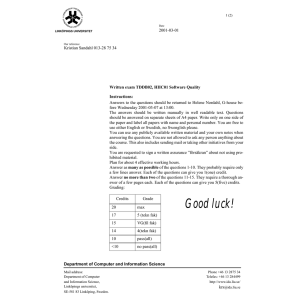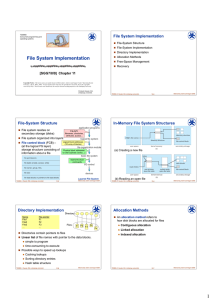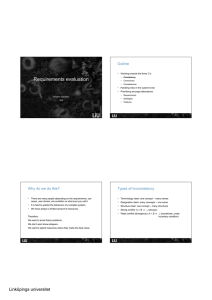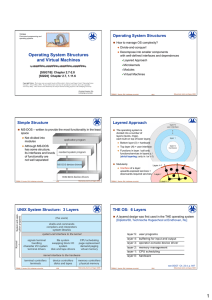Agenda Processes and Threads
advertisement
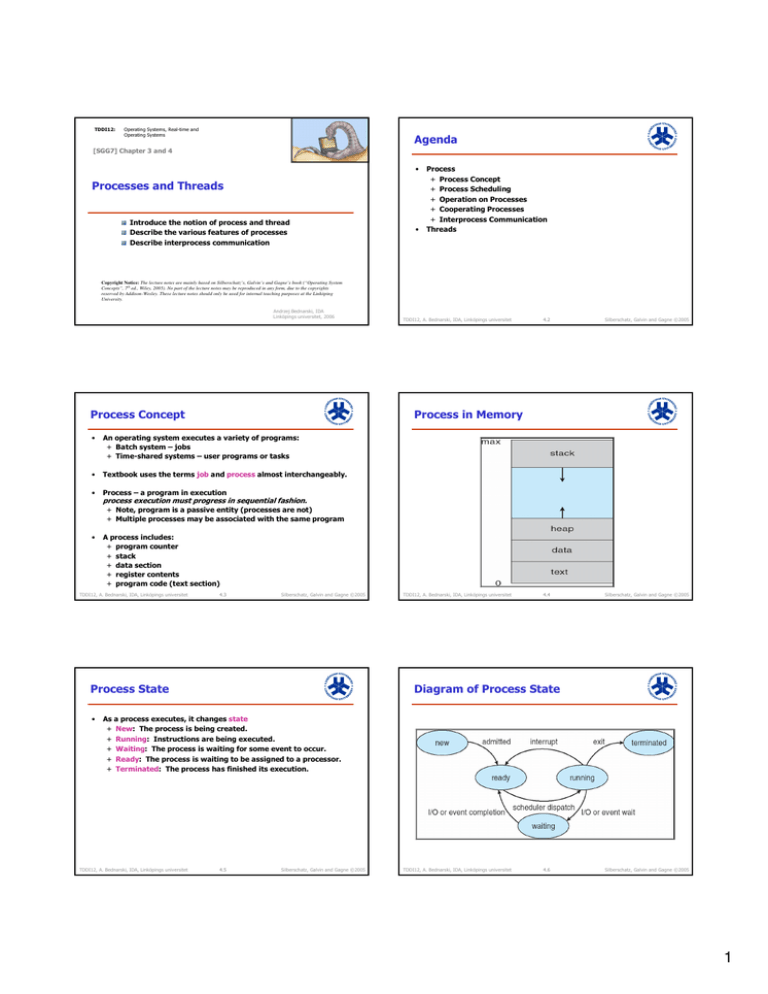
TDDI12:
Operating Systems, Real-time and
Operating Systems
Agenda
[SGG7] Chapter 3 and 4
•
Processes and Threads
Introduce the notion of process and thread
Describe the various features of processes
Describe interprocess communication
•
Process
+ Process Concept
+ Process Scheduling
+ Operation on Processes
+ Cooperating Processes
+ Interprocess Communication
Threads
Copyright Notice: The lecture notes are mainly based on Silberschatz’s, Galvin’s and Gagne’s book (“Operating System
Concepts”, 7th ed., Wiley, 2005). No part of the lecture notes may be reproduced in any form, due to the copyrights
reserved by Addison-Wesley. These lecture notes should only be used for internal teaching purposes at the Linköping
University.
Andrzej Bednarski, IDA
Linköpings universitet, 2006
Process Concept
4.2
Silberschatz, Galvin and Gagne ©2005
4.4
Silberschatz, Galvin and Gagne ©2005
Process in Memory
•
An operating system executes a variety of programs:
+ Batch system – jobs
+ Time-shared systems – user programs or tasks
•
Textbook uses the terms job and process almost interchangeably.
•
TDDI12, A. Bednarski, IDA, Linköpings universitet
Process – a program in execution
process execution must progress in sequential fashion.
+ Note, program is a passive entity (processes are not)
+ Multiple processes may be associated with the same program
•
A process includes:
+ program counter
+ stack
+ data section
+ register contents
+ program code (text section)
TDDI12, A. Bednarski, IDA, Linköpings universitet
4.3
Silberschatz, Galvin and Gagne ©2005
Process State
•
TDDI12, A. Bednarski, IDA, Linköpings universitet
Diagram of Process State
As a process executes, it changes state
+ New: The process is being created.
+ Running: Instructions are being executed.
+ Waiting: The process is waiting for some event to occur.
+ Ready: The process is waiting to be assigned to a processor.
+ Terminated: The process has finished its execution.
TDDI12, A. Bednarski, IDA, Linköpings universitet
4.5
Silberschatz, Galvin and Gagne ©2005
TDDI12, A. Bednarski, IDA, Linköpings universitet
4.6
Silberschatz, Galvin and Gagne ©2005
1
Process Control Block (PCB)
Process Control Block PCB (Cont.)
Information associated with each process.
•
Memory management information
+ Base and limit registers
•
Accounting information
•
I/O status information
+ List of I/O devices allocated to process, open files etc.
•
Process state
+ New, ready, running, waiting, …
•
Program counter
+ Address of the next instruction
•
CPU registers
+ Accumulators, index registers, stack pointers, general-purpose
registers
•
PCB is sometimes denoted as task control block.
CPU scheduling information
+ Process priorities, pointers to scheduling queues etc.
TDDI12, A. Bednarski, IDA, Linköpings universitet
4.7
Silberschatz, Galvin and Gagne ©2005
Process Control Block (PCB)
TDDI12, A. Bednarski, IDA, Linköpings universitet
4.9
Job queue
set of all processes in the system
•
Ready queue
set of all processes residing in main memory,
ready and waiting to execute
•
Device queues
set of processes waiting for an I/O device
4.8
Silberschatz, Galvin and Gagne ©2005
CPU Switch From Process to Process
Silberschatz, Galvin and Gagne ©2005
Process Scheduling Queues
•
TDDI12, A. Bednarski, IDA, Linköpings universitet
TDDI12, A. Bednarski, IDA, Linköpings universitet
4.10
Silberschatz, Galvin and Gagne ©2005
Ready Queue And Various I/O Device Queues
Processes migrate among the various queues
TDDI12, A. Bednarski, IDA, Linköpings universitet
4.11
Silberschatz, Galvin and Gagne ©2005
TDDI12, A. Bednarski, IDA, Linköpings universitet
4.12
Silberschatz, Galvin and Gagne ©2005
2
Representation of Process Scheduling
TDDI12, A. Bednarski, IDA, Linköpings universitet
4.13
Silberschatz, Galvin and Gagne ©2005
Schedulers
•
Long-term scheduler (or job scheduler)
selects which processes should be brought into the ready queue.
•
Short-term scheduler (or CPU scheduler)
selects which process should be executed next and allocates CPU.
TDDI12, A. Bednarski, IDA, Linköpings universitet
4.14
Silberschatz, Galvin and Gagne ©2005
Schedulers (Cont.)
Addition of Medium Term Scheduling
•
Short-term scheduler is invoked very frequently (milliseconds)
⇒ (must be fast).
•
•
Long-term scheduler is invoked very infrequently (sec, min)
⇒ (may be slow).
•
The long-term scheduler controls the degree of multiprogramming.
•
Processes can be described as either:
+ I/O-bound process – spends more time doing I/O than
computations, many short CPU bursts.
+ CPU-bound process – spends more time doing computations;
few very long CPU bursts.
Controls swapping
+ Removes processes from memory
̶ Decreases degree of multiprogramming (swap out)
+ Reloads processes later (swap in)
Best performance:
Balance between I/O-bound and CPU-bound processes
TDDI12, A. Bednarski, IDA, Linköpings universitet
4.15
Silberschatz, Galvin and Gagne ©2005
TDDI12, A. Bednarski, IDA, Linköpings universitet
4.16
Silberschatz, Galvin and Gagne ©2005
Context Switch
Process Creation
•
When CPU switches to another process, the system must
+ save the state of the old process and
+ load the saved state for the new process.
•
Parent process creates children processes, which, in turn create
other processes, forming a tree of processes (system call).
•
•
Context-switch time is overhead
+ the system does no useful work while switching
•
Time dependent on hardware support (from 1µs to 1ms).
+ E.g., consider an architecture having multiple sets of registers.
Resource sharing
Goal: Preventing system overloading
+ Parent and children share all resources.
+ Children share subset of parent’s resources.
+ Parent and child share no resources.
•
Execution
+ Parent and children execute concurrently.
+ Parent waits until children terminate.
TDDI12, A. Bednarski, IDA, Linköpings universitet
4.17
Silberschatz, Galvin and Gagne ©2005
TDDI12, A. Bednarski, IDA, Linköpings universitet
4.18
Silberschatz, Galvin and Gagne ©2005
3
Process Creation (Cont.)
Process Creation (Cont.)
•
Address space
+ Child duplicate of parent
+ Child has a program loaded into it
•
UNIX examples
+ pid - process identifier
+ fork - system call creates new process,
holding a copy of the memory space of the parent process
+ exec - system call used after a fork
to replace the process’ memory space with a new program
•
Windows NT/XP support two models
+ Duplication like fork
+ Creation of new process
with address to new program to be loaded
TDDI12, A. Bednarski, IDA, Linköpings universitet
4.19
Silberschatz, Galvin and Gagne ©2005
C Program Forking Separate Process
TDDI12, A. Bednarski, IDA, Linköpings universitet
4.20
Silberschatz, Galvin and Gagne ©2005
A tree of processes on a typical UNIX system
int main()
{
pid_t pid;
/* fork another process */
pid = fork();
if (pid < 0) { /* error occurred */
fprintf(stderr, "Fork Failed!\n");
exit(-1);
} else if (pid == 0) { /* child process */
execlp("/bin/ls", "ls", NULL);
} else { /* parent process */
/* parent will wait for the child to complete */
wait (NULL);
printf ("Child Complete\n");
exit(0);
}
return 0;
}
TDDI12, A. Bednarski, IDA, Linköpings universitet
4.21
Solaris OS
Silberschatz, Galvin and Gagne ©2005
TDDI12, A. Bednarski, IDA, Linköpings universitet
4.22
Silberschatz, Galvin and Gagne ©2005
Process Termination
Cooperating Processes
•
Process executes last statement (exit) and
asks the operating system to
+ Output data from child to parent (parent issues a wait).
+ Process’ resources are deallocated
(released) by operating system.
•
Independent process cannot affect or be affected by the
execution of another process (no data sharing).
•
Cooperating process can affect or be affected by the execution of
another process
Parent may terminate execution of children processes (abort).
+ Child has exceeded allocated resources
+ Task assigned to child is no longer required
+ Parent is exiting.
̶ Operating system does not allow child to continue if its
parent terminates.
•
Advantages of process cooperation
+ Information sharing
̶ Also enables fault-tolerance, e.g., N-version redundancy
+ Computation speed-up
+ Modularity
+ Convenience
•
̶
̶
Note, this depends on the type of coupling that is supported.
All children terminated - cascading termination
TDDI12, A. Bednarski, IDA, Linköpings universitet
4.23
Silberschatz, Galvin and Gagne ©2005
TDDI12, A. Bednarski, IDA, Linköpings universitet
4.24
Silberschatz, Galvin and Gagne ©2005
4
Producer-Consumer Problem
Interprocess Communication (IPC)
•
•
•
Paradigm for cooperating processes, producer process produces
information that is consumed by a consumer process.
+ unbounded-buffer places no practical limit on the size of the
buffer.
+ bounded-buffer assumes that there is a fixed buffer size.
Variables in, out are initialized to 0
+ n is the number of slots in buffer
+ in points to the next free position in the buffer
+ out points to the first full position in the buffer
+ Buffer is empty when in = out
+ Buffer is full when in + 1 mod n = out
̶ Buffer is a circular array
TDDI12, A. Bednarski, IDA, Linköpings universitet
4.25
Silberschatz, Galvin and Gagne ©2005
Implementation Questions
How are links established?
•
Can a link be associated with more than two processes?
•
How many links can there be between every pair of
communicating processes?
•
What is the capacity of a link?
•
Is the size of a message that the link can accommodate fixed or
variable?
•
Is a link unidirectional or bi-directional?
4.28
•
•
•
TDDI12, A. Bednarski, IDA, Linköpings universitet
4.27
Silberschatz, Galvin and Gagne ©2005
Communications Models
•
TDDI12, A. Bednarski, IDA, Linköpings universitet
•
Mechanism for processes to communicate
and to synchronize their actions.
Message system – processes communicate with each other
without resorting to shared variables.
IPC facility provides two operations:
+ send(message) – message size fixed or variable
+ receive(message)
If P and Q wish to communicate, they need to:
+ establish a communication link between them
+ exchange messages via send/receive
Implementation of communication link
+ physical (e.g., shared memory, hardware bus)
+ logical (e.g., logical properties)
Silberschatz, Galvin and Gagne ©2005
TDDI12, A. Bednarski, IDA, Linköpings universitet
4.29
Silberschatz, Galvin and Gagne ©2005
Direct Communication
Indirect Communication
•
•
Messages are directed and received from mailboxes
(also referred to as ports)
+ Each mailbox has a unique id
+ Processes can communicate only if they share a mailbox
•
Properties of communication link
+ Link established only if processes share a common mailbox
+ A link may be associated with many processes
+ Each pair of processes may share several communication links
+ Link may be unidirectional or bi-directional (usually)
•
Processes must name each other explicitly:
+ send (P, message) – send a message to process P
+ receive(Q, message) – receive a message from process Q
Properties of communication link
+ Links are established automatically
+ A link is associated with exactly one pair of communicating
processes
+ Between each pair there exists exactly one link
+ The link may be unidirectional, but is usually bi-directional
TDDI12, A. Bednarski, IDA, Linköpings universitet
4.30
Silberschatz, Galvin and Gagne ©2005
TDDI12, A. Bednarski, IDA, Linköpings universitet
4.31
Silberschatz, Galvin and Gagne ©2005
5
Indirect Communication (Cont.)
Indirect Communication
•
Operations
+ create a new mailbox
+ send and receive messages through mailbox
+ destroy a mailbox
•
Mailbox sharing
+ P1, P2, and P3 share mailbox A
+ P1, sends; P2 and P3 receive
+ Who gets the message?
•
Primitives are defined as:
send(A, message) – send a message to mailbox A
receive(A, message) – receive a message from mailbox A
•
Solutions
+ Allow a link to be associated with at most two processes
+ Allow only one process at a time to execute a receive operation
+ Allow the system to select arbitrarily the receiver.
Sender is notified who the receiver was.
TDDI12, A. Bednarski, IDA, Linköpings universitet
4.32
Silberschatz, Galvin and Gagne ©2005
TDDI12, A. Bednarski, IDA, Linköpings universitet
4.33
Synchronization
Buffering
•
•
Temporary queues
•
Queue of messages attached to the link;
implemented in one of three ways.
Communication: send/receive primitives
(different implementations)
+ Blocking/Synchronous
̶ send: sender blocked until message received (phone)
̶ receive: receiver blocks until a message is available
Silberschatz, Galvin and Gagne ©2005
1. Zero capacity – 0 messages
Sender must wait for receiver (rendez-vous).
“message system with no buffering”
+ Nonblocking/Asynchronous
̶ send: sends and resumes (SMS)
̶ receive: if there is a message, retrieve it, otherwise empty
message (classical mail box)
2. Bounded capacity – finite length of n messages
Sender must wait if link full.
“automatic buffering”
3. Unbounded capacity – infinite length
Sender never waits.
“automatic buffering”
TDDI12, A. Bednarski, IDA, Linköpings universitet
4.34
Silberschatz, Galvin and Gagne ©2005
TDDI12, A. Bednarski, IDA, Linköpings universitet
Client-Server Communication
Sockets
•
•
•
•
•
•
•
Sockets
Remote Procedure Calls
Remote Method Invocation (Java)
TDDI12, A. Bednarski, IDA, Linköpings universitet
4.36
Silberschatz, Galvin and Gagne ©2005
4.35
Silberschatz, Galvin and Gagne ©2005
A socket is defined as an endpoint for communication
Concatenation of IP address and port
The socket 146.86.5.20:1625 refers to port 1625 on host 146.86.5.20
Communication consists between a pair of sockets
TDDI12, A. Bednarski, IDA, Linköpings universitet
4.37
Silberschatz, Galvin and Gagne ©2005
6
Remote Procedure Calls
Marshalling Parameters
•
Remote procedure call (RPC) abstracts procedure calls between
processes on networked systems.
•
stubs – client-side proxy for the actual procedure on the server.
•
The client-side stub locates the server and
marshalls the parameters.
•
The server-side stub receives this message,
unpacks the marshalled parameters,
and performs the procedure on the server.
TDDI12, A. Bednarski, IDA, Linköpings universitet
4.38
Silberschatz, Galvin and Gagne ©2005
Execution of RPC
TDDI12, A. Bednarski, IDA, Linköpings universitet
Silberschatz, Galvin and Gagne ©2005
Remote Method Invocation
•
•
TDDI12, A. Bednarski, IDA, Linköpings universitet
4.39
4.40
Silberschatz, Galvin and Gagne ©2005
Threads
Remote Method Invocation (RMI)
is a Java mechanism similar to RPCs.
RMI allows a Java program on one virtual machine
to invoke a method on a remote object (on another VM).
TDDI12, A. Bednarski, IDA, Linköpings universitet
4.41
Silberschatz, Galvin and Gagne ©2005
Single and Multithreaded Processes
•
A thread (or lightweight process) is a basic unit of CPU utilization;
it consists of:
+ program counter
+ register set
+ stack space
•
A thread shares with its peer threads its:
+ code section
+ data section
+ operating-system resources
collectively know as a task.
•
A traditional or heavyweight process
is equal to a task with one thread
Advantage: Use of threads minimizes context switches
without loosing parallelism.
TDDI12, A. Bednarski, IDA, Linköpings universitet
4.42
Silberschatz, Galvin and Gagne ©2005
TDDI12, A. Bednarski, IDA, Linköpings universitet
4.43
Silberschatz, Galvin and Gagne ©2005
7
User/Kernel Threads
Multithreading Models
•
User threads
+ Thread management done by user-level threads library
(POSIX Pthreads, Win32 threads, Java threads)
•
Kernel threads
+ Supported by the kernel
(Windows XP/2000, Solaris, Linux, True64 UNIX, Mac OS X)
One-to-one
Many-to-one
Many-to-many
TDDI12, A. Bednarski, IDA, Linköpings universitet
4.44
Silberschatz, Galvin and Gagne ©2005
TDDI12, A. Bednarski, IDA, Linköpings universitet
4.45
Silberschatz, Galvin and Gagne ©2005
Thread Cancellation
Signal Handling
•
Terminating a thread before it has finished
•
Signals are used in UNIX systems to notify a process that a
particular event has occurred
•
Two general approaches:
+ Asynchronous cancellation terminates the target thread
immediately
+ Deferred cancellation allows the target thread to periodically
check if it should be cancelled
•
A signal handler is used to process signals
1. Signal is generated by particular event
2. Signal is delivered to a process
3. Signal is handled
•
Options:
+ Deliver the signal to the thread to which the signal applies
+ Deliver the signal to every thread in the process
+ Deliver the signal to certain threads in the process
+ Assign a specific thread to receive all signals for the process
TDDI12, A. Bednarski, IDA, Linköpings universitet
4.46
Silberschatz, Galvin and Gagne ©2005
TDDI12, A. Bednarski, IDA, Linköpings universitet
4.47
Silberschatz, Galvin and Gagne ©2005
Thread Pools
Recommended Reading and Exercises
•
Create a number of threads in a pool where they await work
•
•
Advantages:
+ Usually slightly faster to serve a request
+ Bounded number of threads in the application
Reading
+ Chapter 3 and 4 [SGG7]
Chapter 4 and 5 (6th edition)
Chapter 4 (5th edition)
Optional but recommended:
Section 3.5 and 3.6
RPC, Client/Server, Sockets, RMI, Mach OS
Section 4.3 and 4.5
•
Exercises:
+ 3.1 to 3.6
+ 3.7-3.11 (implementation)
̶ Project: UNIX shell
+ 4.1 to 4.8
+ 4.8-4.12 (implementation)
̶ Project: Matrix multiplication using threads
TDDI12, A. Bednarski, IDA, Linköpings universitet
4.48
Silberschatz, Galvin and Gagne ©2005
TDDI12, A. Bednarski, IDA, Linköpings universitet
4.49
Silberschatz, Galvin and Gagne ©2005
8
